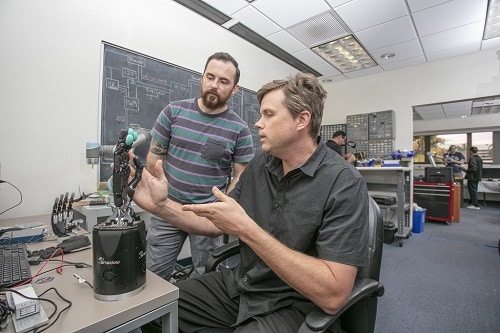With the help of innovative controller design and biomimetics, the creation aims to improve the quality of life of disabled people

Touch and feel are sensations that we able-bodied humans take for granted. A person with an artificial arm is deprived of that sensation. Current myoelectric prosthetic hands allow users to control one grasp function at a time even though modern artificial hands are mechanically capable of controlling all five fingers individually.
Now researchers from the College of Engineering and Computer Science in collaboration with Charles E. Schmidt College of Science, both at Florida Atlantic University (FAU), have designed a wearable soft robotic armband that conveys artificial sensations of touch to its users. The researchers have worked on controlling the grip force of an artificial hand for grasping two different objects simultaneously. Additionally, they also studied the role of visual and haptic feedback in the system.
Benefits included saving time due to faster transportation of objects by the user as compared to a slow one-at-a-time approach. Also, objects were successfully grasped without breaking or dropping them, even when the vision of both objects was obstructed. The progress could revolutionise the way current and future artificial hands are controlled by limb-absent people.
“Our study demonstrates the feasibility of this complex simultaneous control task while integrating multiple channels of haptic feedback noninvasively,” said Erik Engeberg, PhD and professor at the Department of Ocean and Mechanical Engineering, College of Engineering and Computer Science, a member of FAU’s Center for Complex Systems and Brain Sciences, Charles E. Schmidt College of Science, and a member of I-SENSE and the FAU Stiles-Nicholson Brain Institute. “None of our study participants had significant prior use of EMG-controlled artificial hands, yet they were able to learn to harness this multitasking functionality after two short training sessions.”
The armband was fitted with soft actuators to convey a proportional sense of contact forces; vibrotactile stimulators were included to indicate if the grasped object(s) had been broken (if one or both force thresholds exceeded). The armband was designed for haptic feedback at three locations corresponding to the thumb, index, and little finger. EMG control was added and designed of the custom fabricated multichannel bimodal soft robotic armband.
“Examples of multifunction control demonstrated in our study included the proportional control of a card being pinched between the index and middle fingers at the same time that the thumb and little finger were used to unscrew the lid of a water bottle. Another simultaneous control demonstration was with a ball that was grasped with three fingers while the little finger was simultaneously used to toggle a light switch,” said Moaed A. Abd, PhD student in FAU’s Department of Ocean and Mechanical Engineering.
Information discovered from the study could be used in the future frameworks of highly complex bimanual operations, such as those required of surgeons and guitarists, to enable upper limb-absent people to pursue career paths and recreational pursuits currently unattainable to them.
“Enabling refined dexterous control is a highly complex problem to solve and continues to be an active area of research because it necessitates not only the interpretation of human grasp control intentions but also complementary haptic feedback of tactile sensations,” said Stella Batalama, PhD and dean, FAU College of Engineering and Computer Science. “With this innovative study, our researchers are addressing the loss of tactile sensations, which is currently a major roadblock in preventing upper limb-absent people from multitasking or using the full dexterity of their prosthetic hands.”
Read here for more







